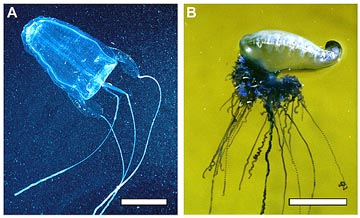 |
Recognize box jellyfish, left, by its clear color and pink tentacles. Portuguese man of war, right, is a surface-dweller.
Photo A courtesy Waikiki Aquarium; photo B by D.R. and T.L. Schrichte
|
By Katherine Nichols
Advertiser Staff Writers
Can’t tell the difference between a Portuguese man-of-war and Hawaiian box jellyfish? Read on.
Portuguese man-of-war float on the surface with a bluish purple gas-filled sac, and are blown in by trade winds; this is why they frequent the windward side of the island and often sting surfers and swimmers there. Staff guard Landy Blair estimated that 99.99 percent of stings on the windward side (with the highest numbers of stings at Waimanalo, Bellows, and Kailua beaches) come from the Portuguese man-of-war.
Instead of floating on the surface or sailing with the wind, box jellyfish swim purposefully toward shore eight to 10 days after the full moon. Blair estimated that 90 to 95 percent of sting victims at Ala Moana, Waikiki, and on the Wai‘anae Coast are the result of box jellyfish.
Box jellyfish are clear and difficult to see, but aside from the days when they approach shore to spawn, they linger in deep water and pose little threat to anybody except divers. Portuguese man-of-war are more visible because of their blue color and their location on the surface.
Man-of-war have blue tentacles, while box jellyfish tentacles are pink. Electron micrographs reveal that the tubules of the nematocysts on those tentacles are also dramatically different. According to University of Hawai‘i biochemist Angel Yanagihara, the man-of-war’s are tiny and don’t take hold in human tissue — in fact, they might not penetrate the skin at all — but the box jellyfish has large, flaky spines that act as hooks, embedding themselves in the skin as the nematocyst fires.
If anything from the Portuguese man-of-war does penetrate the skin, said Yanagihara, enzymatic studies have shown that it dissolves on its own. The best news is that there are no reports of prolonged dermatological problems with man-of-war stings; reactions to Portuguese man-of-war stings are usually less serious.
Dr. Craig Thomas agreed: "In my clinical practice, my sense is that box stings are worse."
In Thomas’ book "All Stings Considered," he wrote that the "classic Portuguese man-of-war sting in Hawai‘i causes an immediate burning sensation, with slight reddening where the tentacles touched. The pain and redness disappear after 20 minutes to an hour with no treatment." However, some people can be extremely sensitive to the venom.
The "classic box jellyfish sting in Hawaii causes immediate, sometimes severe, pain and a burning sensation lasting 10 minutes to eight hours," he wrote. A red, hive-like welt forms, sometimes in the shape of "raised whips of fine parallel lines." Victims can suffer from chills, fever, malaise, vomiting and abdominal pain in extreme cases. If the victim’s breathing is affected in either case, he or she should be transported to the hospital or an ambulance should be called.
[back to top] |

 The Great Index to Fun
The Great Index to Fun